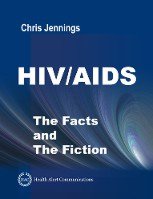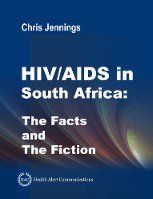In this brief teaser video, Chris Jennings describes how Bermuda and Bahamas had the highest HIV/AIDS rate in the world at the beginning of the HIV/AIDS epidemic. Also, notably, HIV/AIDS was absent from Cuba because no Americans were allowed to enter Cuba.
This brief video is an excerpt from Chris Jennings full lecture: New York City – The Epicenter of the HIV/AIDS Epidemic, which summarizes the first portion of Chris Jennings seminal book, HIV/AIDS – The Facts and The Fiction. The full lecture, New York City – The Epicenter of the HIV/AIDS Epidemic, will be broadcast as a Facebook Premier Event on November 3, 2020. Sign up for the Event here.
Date: November 3, 2020
Time: 1 PM EST (18:00 GMT)
Web Link: To Be Announced
Click Here to Join the Facebook Event
Click Here to Subscribe to our Newsletter for Updates
 James Chin, MD, MPH was the former Chief of the Surveillance, Forecasting, and Impact Assessment Unit for the Global Programme on AIDS (GPA) at the World Health Organization (WHO) between 1987 and 1992. From hearsay, I understand that Dr. Chin quit WHO in protest over WHO’s consistent use and distribution of the highest computer estimates for global HIV/AIDS statistics.
James Chin, MD, MPH was the former Chief of the Surveillance, Forecasting, and Impact Assessment Unit for the Global Programme on AIDS (GPA) at the World Health Organization (WHO) between 1987 and 1992. From hearsay, I understand that Dr. Chin quit WHO in protest over WHO’s consistent use and distribution of the highest computer estimates for global HIV/AIDS statistics.
Nevertheless, he did not leave quietly, and trumpeted his views in the booklet The Myth of a General AIDS Pandemic: How billions are wasted on unnecessary AIDS prevention programmes. The title of this document is forthright, and it contains strong words inside as well: Continue reading
 Contrary to popular belief, the HIV incubation period does not have a 10-year average. On the lower end, the HIV incubation period is 8 to 24 months, according to research conducted by the Centers for Disease Control (CDC) at the beginning of the HIV/AIDS epidemic.
Contrary to popular belief, the HIV incubation period does not have a 10-year average. On the lower end, the HIV incubation period is 8 to 24 months, according to research conducted by the Centers for Disease Control (CDC) at the beginning of the HIV/AIDS epidemic.
Continue reading
 In the words of René Dubos: “It’s easy to think you are emptying the ocean with a bucket when the tide is going out.”
In the words of René Dubos: “It’s easy to think you are emptying the ocean with a bucket when the tide is going out.”
Perhaps I paraphrase. The quote is derived from Dubos’ book, Mirage of Health. His writing is focused on the history of science and a wonderful discourse on the cyclic and repetitive nature of social thought and concepts of health and disease. To quote an Amazon.com reviewer: “extremely interesting reading for anyone interested in humanity, disease, science and history.” Continue reading
 HIV/AIDS statistics in South Africa (and Botswana) are entirely implausible. Given the known rates of HIV sexual transmission during vaginal intercourse, the purported current rates of HIV prevalence among the heterosexual adults of these countries exceed all plausible limits of human sexual activity. In this video presentation, Chris Jennings explains why the statistics for HIV/AIDS prevalence in South Africa are entirely implausibility (with mention of Botswana and New York City).
HIV/AIDS statistics in South Africa (and Botswana) are entirely implausible. Given the known rates of HIV sexual transmission during vaginal intercourse, the purported current rates of HIV prevalence among the heterosexual adults of these countries exceed all plausible limits of human sexual activity. In this video presentation, Chris Jennings explains why the statistics for HIV/AIDS prevalence in South Africa are entirely implausibility (with mention of Botswana and New York City).
 Will Solimene Award from American Medical Writers Association (AMWA) Recognizes the Innovative Research, Definitive Analytics, and Scientific Conclusions challenging HIV/AIDS Statistics in South Africa
Will Solimene Award from American Medical Writers Association (AMWA) Recognizes the Innovative Research, Definitive Analytics, and Scientific Conclusions challenging HIV/AIDS Statistics in South Africa
Cambridge, Massachusetts, U.S.A.: The book HIV/AIDS in South Africa by Chris Jennings was awarded the 2014 Will Solimene Award for Excellence in Medical Communication. The Solimene Award recognizes outstanding work in medical, biomedical, and health communication published during the previous two years.

Recently, a web page of National Public Radio stated “AIDS is the primary killer of African-Americans ages 19 to 44 years of age.” This misconception is evidently a common one. For example, Peter Piot, the Executive Director of UNAIDS, had broadcast the same belief previously, i.e., “AIDS remains the leading cause of death in African-American women in the USA.” [1] Neither statement is accurate.

Is the use of estimates in measuring HIV/AIDS leading to other diseases being wrongly classified?
Few people realise that the familiar HIV/AIDS global statistics that one sees, hears, and reads in the media are actually just estimates. The numbers you hear are not actual counts of HIV/AIDS cases nor actual counts HIV/AIDS deaths. Only estimates generated by computers.
For example, UNAIDS estimated that South Africa had 140,000 HIV/AIDS deaths in 1997. However, after tabulating all death certificates for 1997, South Africa attributed only 6,635 deaths to HIV/AIDS.



